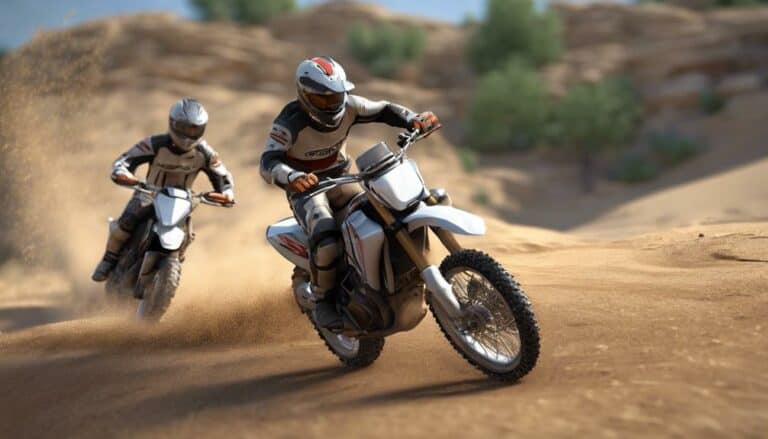When traversing the twists and turns of off-road trails, cornering on a motorcycle is like dancing with the terrain.
Imagine the thrill of mastering different cornering techniques to enhance your riding skills. Each method offers a unique blend of control and speed, but how do they truly compare against each other?
Let's explore the intricacies of these cornering styles and dissect the nuances that separate them. Understanding the differences could be the key to unleashing your full potential on the off-road track.
Key Takeaways
- Adapt cornering technique to bike type for optimal performance.
- Body positioning influences stability and traction in corners.
- Speed management crucial for control and momentum in cornering.
- Line selection impacts front end control and rear wheel traction.
Cornering Techniques in Off-Road Motorcycle Riding
Adapting your cornering technique to the specific power and torque characteristics of your off-road motorcycle is essential for mastering the art of handling tight turns effectively. When comparing cornering techniques between 2-strokes and 4-strokes, distinct differences emerge. 2-strokes, known for their sharp power delivery, often require a point-and-shoot approach to cornering. In contrast, 4-strokes with their smoother power delivery excel in taking rounder corners, requiring a different strategy altogether.
Understanding these nuances is vital for optimizing your performance on the trail. For 2-strokes, focusing on quick bursts of acceleration out of corners is key, while 4-strokes benefit from a smoother, more consistent throttle control throughout the turn. The change between these two types of bikes can pose challenges, as riders must adjust their cornering lines and throttle control to accommodate the varying power delivery.
Comparing Body Positioning for Cornering
When comparing body positioning for off-road motorcycle cornering, prime stability and control are achieved by leaning forward into the seat pocket while maintaining raised elbows for support and structure. To optimize your performance in corners, consider the following:
- Body Weight Distribution: Shift your body weight slightly forward to enhance traction on the front wheel, aiding in steering and maintaining control throughout the corner.
- Elbow Positioning: Keep your elbows up and out to create a stable platform, allowing you to absorb bumps and impacts while maintaining control over the bike.
- Utilizing the Front Brake: Lightly apply the front brake to adjust your speed before entering the corner, ensuring you have the right pace to navigate it smoothly.
- Managing Corner Speed: Adjust your body positioning and lean angle to regulate your corner speed effectively, enabling you to exit the turn with peak speed and control.
Evaluating Speed Management in Corners
To refine your off-road motorcycle cornering skills, understanding how to evaluate speed management in corners is key for maintaining control and maximizing performance. Speed management in off-road motorcycle cornering involves a delicate balance of throttle and braking inputs, especially on varying terrains. Anticipating changes in traction is vital for adjusting your speed to make control through corners. Proper speed management not only aids in maintaining control but also allows riders to carry momentum efficiently, especially in tight off-road corners. Experienced riders utilize a combination of precise body positioning and throttle control to effectively manage speed when cornering off-road, preventing skidding and maintaining traction in challenging conditions.
| Speed Management Tips | Description |
|---|---|
| Anticipate Changes | Be ready to adjust speed based on terrain and traction. |
| Balance is Key | Maintain a balance between speed and control. |
| Utilize Body Position | Proper body positioning aids in speed management. |
Assessing Line Selection for Cornering
Evaluating line selection for cornering on off-road motorcycles demands a strategic approach to optimize control and traction through varying terrain types and obstacles. When steering corners, consider these key factors:
- Front End Control: Proper line selection guarantees you position the front end of the motorcycle optimally to tackle the corner's entry and exit points. By picking the right line, you can maintain stability and steer the bike effectively through the turn.
- Rear Wheel Traction: Selecting the correct line helps in managing the rear wheel's grip on the terrain. By picking a line that offers better traction, you can accelerate out of the corner smoothly and with control.
- Leaning the Bike: The chosen line dictates how much you need to lean the motorcycle into the corner. By picking the most suitable line, you can lean the bike at the right angle, maximizing your ability to steer the turn efficiently.
- Adapting to Terrain: Different terrain types demand different line choices. By evaluating the obstacles and surface variations, you can adjust your line selection to guarantee smoother cornering and enhanced overall performance. Optimum line selection is key to unlocking your off-road cornering potential.
Analyzing Braking Techniques for Cornering
In off-road motorcycle cornering, mastering braking techniques is essential for ideal control and stability through varying terrain conditions. When approaching a corner, understanding the nuances between front and rear brake application is vital.
Utilizing the front brake helps to settle the suspension, increasing traction on the front wheel, and aids in initiating the turn smoothly. On the other hand, applying the rear brake can assist in controlling speed and maintaining stability throughout the corner, preventing the rear wheel from sliding out.
The key to effective off-road cornering lies in finding the balance between front and rear brake usage. Proper weight transfer through skillful modulation of both brakes can enhance control, especially on challenging surfaces.
Conclusion
To sum up, different off-road motorcycle cornering techniques offer unique approaches to maneuvering turns. By comparing body positioning, speed management, line selection, and braking techniques, riders can determine which style suits their preferences and riding conditions best.
Remember, mastering these techniques requires practice, precision, and a deep understanding of the dynamics involved. So, whether you prefer the point-and-shoot style or the corner speed style, honing your skills will ultimately lead to improved performance on the trails.

